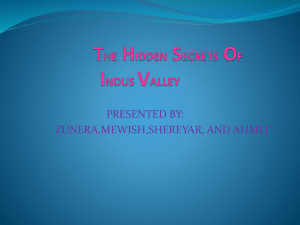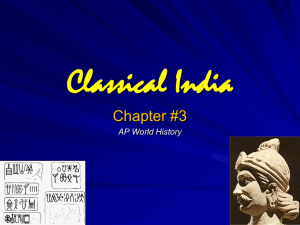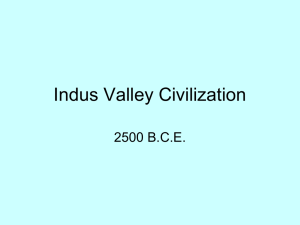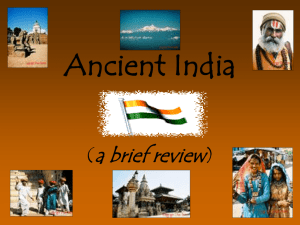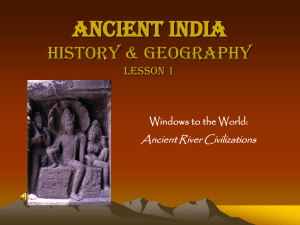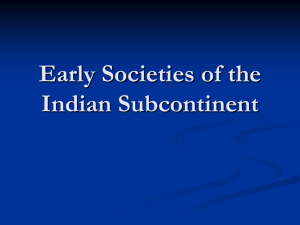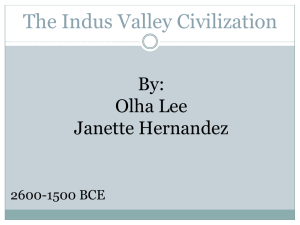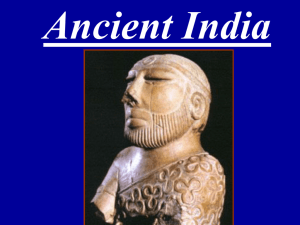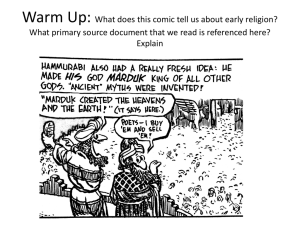Writing System of the Indus River Valley
advertisement
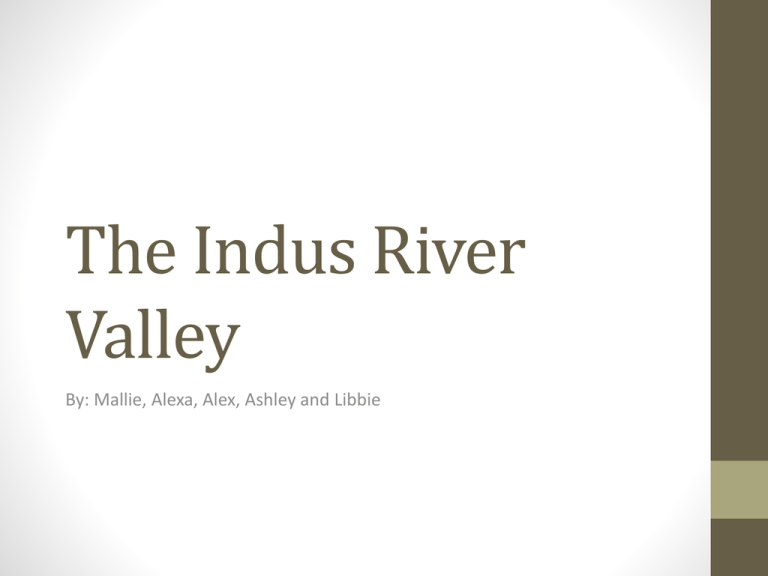
The Indus River Valley By: Mallie, Alexa, Alex, Ashley and Libbie Social Systems • What is the difference between the Caste and Varna System’s? • The Caste System • The Indus River Valley was divided into separate but close communities called “Castes” • The Castes were separated by a person’s social class. • Varna System • • • Varna is Sanskrit for “Color” This system was very similar to the Caste system, but instead of being separated by social class, the people were separated by color, with fair skinned people having more worth than the darker skinned people This came about when the fair skinned Aryans conquered the Dravidians and other dark skinned non Aryans Social Systems • Dharma • Defined as good and acceptable behavior • In the religion Hinduism, Dharma means to conduct one’s behavior in a way that society is positively affected by it. • Karma • Defined as “the spiritual energy based on the law of cause and effect determined by your actions.” • In the Indus River Valley, Karma was widely practiced with the belief that if you were a good person, good things will happen to you. Writing System of the Indus River Valley • The main language is Sanskrit and the primary texts were the Vedas. • Sanskrit literally translates to mean refined, consecrated and sanctified. It is the classical language of Indian culture and is still used today for religious and scientific discourse. • Sanskrit is thought to of evolved into the hundreds of modern Indian languages. Sanskrit itself is still spoken and is one of the twenty-two main languages. • Vedic Sanskrit is the pre-classical form and liturgical language of Vedic religion. This text is written in the Vedas, which are the original scriptures of Hindu teachings. Writing System Continued... • When were the Vedas written? • The Vedas are the primary texts of Hinduism. They manifest the language of God in human speech and are the highest religious authority for all sections of Hindus. • There are four Vedas; Rig(Book of Mantra), Sama(Book of Song), Yajur(Book of Ritual) and Atharva(Book of Spell). Rig Veda is the first to be written in 300 B.C. but it was originally composed in 1500 B.C. It is unknown when the others were written. Indus Valley City Structure • • • • • • • What was the general layout of cities in the Indus Valley? The most developed cities in the Indus River Valley were Mohenjo-Daro and Harappa. Before building a city, mud-brick platforms were laid out to protect from flooding. Each city was also surrounded by a thick brick wall to prevent flooding. The Indus Valley people laid out there cities on a precise grid system instead of winding streets. They also had a sophisticated plumbing and sewage system. Almost every house in Mohenjo-Daro had a private bathroom and toilet. In each city was a fortified area called a citadel, which contained the major buildings of the city. The buildings were built of oven backed bricks cut into standard sizes. Religion • Hinduism• Dates back to 2000 BCE • Hinduism is different then every other religion because there is no specific founder, date, origin, single system of morality, a central religious authority, a single holy text, or a single concept of deity • Often practiced as an monotheistic religion recognizing a single deity and other Gods and Goddesses as aspects of that deity, as well as polytheistic, where they worshipped many different Gods and Goddesses • Archaeologist have found traces of Hindu writings, baths that may have been used in ritual religious bathing, structures that may have resembles altars for animal sacrifice, and some figurines that may resemble Hindu Gods in the Indus River Valley Religion • What is the goal of Hinduism? • Brahman• Part of the Hindu religion • Defined as “a Devine essence of world spirit” • This “spirit” resides within every living thing, and everything is a part of the World Spirit • The goal of Hinduism is to achieve Brahman, and this is done by completing a long process of purification through a series of reincarnation Religion • Reincarnation • Hindu’s believe that once your physical body dies, your spirit is born again as a new being, whether it be as a human or an animal • The way you have lived your past life determines what type of being you will be reincarnated as. • Example- If you have followed the teachings of Hinduism throughout your life, you will come back as a human, or something of high social standards Law Codes • Did Hinduism effect Indian laws? • Hindu beliefs control every aspect of a person’s life. • Hinduism determined what you ate and how. • Personal cleanliness. • How to dress. • The people they can associate with. Role of Women • Women were described with no importance. • They have no spiritual or physical strength. • They “Spoil” and discourage the man’s spiritual concerns. • Women actually have great significance. • Some rituals were only preformed by women. Goddesses • How many goddesses did the ancient Indians believe in? • The Indians regarded nature and its elements as female. • With that mind set the ancient Indians believed in 43 goddesses/queens. • Each goddess is specialized In one area of nature. • Aditi is the sun goddess. 1 • Sarasvati is the goddess of poetry. 2 • Durga is the warrior goddess. 3 3 2 1 Arranged Marriages • In ancient India an arranged marriage was more strict than an arranged marriage is today. • No consent was asked from the bride or groom. • which sometimes led to resentment with brides and grooms who are not ready to get married. Q: What was the geography like in the Indus River Valley Civilization? • Area covered most of Pakistan, extending from Baluchistan to Sindh • Natural borders consisted of mountains and the Arabian Sea • The Indus River was the epicenter of the civilization • The water from the river fertilized and irrigated crops http://www.allabouthistory.org/indus-valley.htm Q: How did having no army affect the downfall of the Indus River Valley Civilization? • They were very peaceful people. • They did not have a mighty army. • A common myth says that when the civilization started to fall apart, Aryan invaders moved in from the North. • This is a very common myth but not true because the people left on their own when the civilization fell apart. http://www.archaeologyonline.net/artifacts/aryan-harappanmyth.html Political Structure and Rulers • The first inhabitants of the Indus River Valley were the Early Harappan. Who lived in well organized villages with no definitive leader, the people of the village all supported there selves and each other. • By 2600 BC, The Mature Harappan era formed and the tight nit villages turned into large urban centers. With the development of cities and the inhabitants, the Political structure developed as well. They looked to “Priest Kings” for guidance. However, the mass population were still very independent. A lower class and an upper class formed with the development of the of Mature Harappan cities. • Around 1800 BCE, signs of decay emerged, and by 1700 BCE most cities were abandoned. This decay was caused by drought and the decline of trade with Egypt. The political structure collapsed with the cities and the Harappans began to live as they did in the Early era or they fled to other civilizations. This period of decay was the Late Happaran era. • Who were the first civilized inhabitants of the Indus River Valley? The Early Harappan Technology of the Indus River Valley Technology of the Early Harappan • Basic fishing nets, poles, lines, and hooks to fish in the nearby Ravi river for sustenance and trade. • Early Harappan relied heavily on agriculture so they had plows, for which their cattle would pull. Also, the used farm equipment such as saws, hammers, shovels, hoes, and spades. This equipment would normally be made from stone or bronze. Technology of the Mature Harappan • With advance of cities, the Harappa began to make more advanced housing. They had bath tubs and an advance waste water disposal system. • Advanced architecture was utilized in the cities. They built impressive dockyards, granaries, warehouses, brick platforms, and protective walls. • Signs of dentistry were actually found on 9 specimens, indicating there value of hygiene. • The Mature Harappan used bollock carts to transport goods and use around the farm. Technology of the Late Harappan • The technology of the late Harappan remained the same as the Mature Harappan until the invasion of the Aryans and a severe drought that eventually lead to the disappearance of Harappan culture. • What type of carts did the Mature Harappan use to transport goods? A bollock cart Economy and Trade of the Harappan Economy/Trade of Early Harappan Because of the relatively simple way of life of the early Harappan the economy was virtually absent. Everybody was equal. The Early Harappan trading was local until the Mature Harappan era. Economy/Trade of Mature Harappan With the development of cities and wealth, a economic statuses arose. Some people benefited more than others. However, people for the most part, were still equal. The Mature Harappan civilizations depended heavily on trade, to fund their cities. The Mature Harappan traded by sea and by land. They mostly traded crops for raw materials to build their cities. Economy/Trade of the Late Harappan Trade and economy suffered once invaders plundered their prized cities, the land suffered from a drought, and trade with Egypt suffered. • What natural disaster was one of the causes of the downfall of Harappan civilization? Drought Works Cited "Class System- Indus Valley." Period40910. Matthew, Towey & Krissy, n.d. Web. 12 Jan 2012. <http://period40910.wikispaces.com/Class SystemIndus Valley>. Colaco, Jose. "The caste System of India." Colaco. The goan Forum, 11 January 2004. Web. 12 Jan 2012. <http://www.colaco.net/1/caste.htm>. "Hindu Dharma." Dharma Bhakiti. Darma Bhakiti, n.d. Web. 12 Jan 2012. <http://www.dharmabhakti.org/hindudharma.php>. Cite • http://www.indiatemplesinfo.com/india/goddess/ • http://www.iloveindia.com/history/ancient-india/gods-goddess.html • http://thegoddesshouse.blogspot.com/2010/12/many-goddessesof-india.html • http://www.culturalindia.net/weddings/arranged-marriage.html • http://www.essortment.com/ancient-indian-culture-social-theory63717.html • http://wiki.answers.com/Q/How_did_Hinduism_effect_the_society • http://shahrahul.wordpress.com/category/general/page/2/ • http://www.omniglot.com/writing/sanskrit.htm • http://www.sacred-texts.com/hin/ • http://hinduism.about.com/cs/vedasvedanta/a/aa12010 3a.htm
